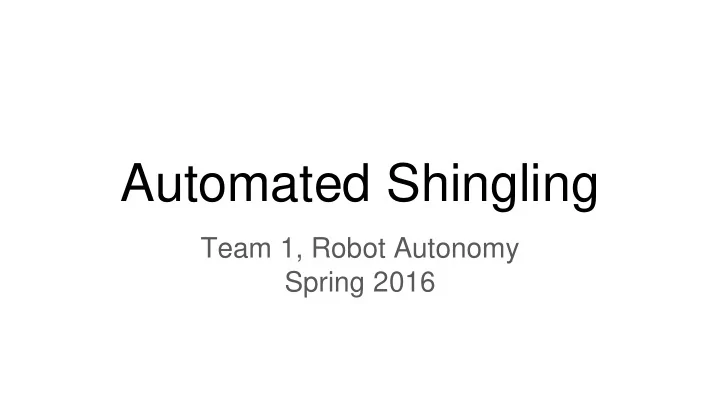

Automated Shingling Team 1, Robot Autonomy Spring 2016
Outline The Problem Background What we’re doing Surface Tessellation Shingle Preparation Trajectory Generation Work Object Definitions Final Product
The Challenge Give the dFAB lab a means of generating, visualizing, and implementing shingle patterns for complex surfaces. Integrate it with their existing workflow and output the result using an ABB IRB 4400.
Background Shingling are a manual-labor • intensive process Architects are looking tools for • both design and implementation Tools used integrated with • architect’s workflow
Approach Software: Rhino Grasshopper HAL ABB Robot Studio Hardware ABB IRB 4400 Custom End-Effector
Surface Tessellation • Break the surface into a grid • Analyse the grid sequentially and divide into shingles based on the parameters • Calculate a grasp point and grasp normal for each shingle
Shingle Preparation • Process the prepared cut list • Generate file for laser cutting the shingles • Generate trajectories for the robot to prepare the shingles • Modify shingle by engraving serial number and drilling holes as per our holder
Trajectory Generation • Plan approach towards the pick and place points • Train the tool/end effector and the objects in the environment • Configure modules for I/O ports to actuate the end effector
Work Object Definitions (Reference Objects) • 2 reference frames (Foam Piece and Shingle Dispenser) • Coordinate frame definition on software • Association of trajectory points to reference frames • Training robot and defining coordinate frames in robot frame • Execution
Inputs Outputs • Surface to be shingled • List of shingles generated and their file (to be input in a laser cutter) • Maximum Dimensions of a shingle • Pick points • Gap between shingles in the same row • Place points • Overlap Between shingles from 2 different rows • Nail Points • Pattern on the bottom of each row • Trajectory • RAPID Code
Final Product - Video https://www.youtube.com/watch?v=rDl49Gicg_g
Recommend
More recommend